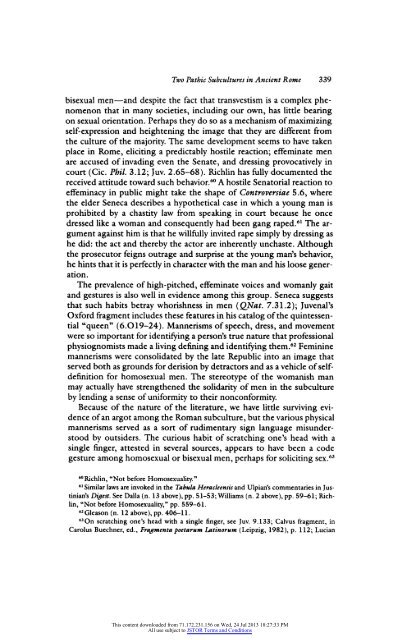Two Pathic Subcultures in Ancient Rome
Two Pathic Subcultures in Ancient Rome
Two Pathic Subcultures in Ancient Rome
Create successful ePaper yourself
Turn your PDF publications into a flip-book with our unique Google optimized e-Paper software.
<strong>Two</strong> <strong>Pathic</strong> <strong>Subcultures</strong> <strong>in</strong> <strong>Ancient</strong> <strong>Rome</strong> 339<br />
bisexual men-and despite the fact that transvestism is a complex phenomenon<br />
that <strong>in</strong> many societies, <strong>in</strong>clud<strong>in</strong>g our own, has little bear<strong>in</strong>g<br />
on sexual orientation. Perhaps they do so as a mechanism of maximiz<strong>in</strong>g<br />
self-expression and heighten<strong>in</strong>g the image that they are different from<br />
the culture of the majority. The same development seems to have taken<br />
place <strong>in</strong> <strong>Rome</strong>, elicit<strong>in</strong>g a predictably hostile reaction; effem<strong>in</strong>ate men<br />
are accused of <strong>in</strong>vad<strong>in</strong>g even the Senate, and dress<strong>in</strong>g provocatively <strong>in</strong><br />
court (Cic. Phil. 3.12; Juv. 2.65-68). Richl<strong>in</strong> has frilly documented the<br />
received attitude toward such behavior."' A hostile Senatorial reaction to<br />
effem<strong>in</strong>acy <strong>in</strong> public might take the shape of Controversiae 5.6, where<br />
the elder Seneca describes a hypothetical case <strong>in</strong> which a young man is<br />
prohibited by a chastity law from speak<strong>in</strong>g <strong>in</strong> court because he once<br />
dressed like a woman and consequently had been gang raped.6' The argument<br />
aga<strong>in</strong>st him is that he willfully <strong>in</strong>vited rape simply by dress<strong>in</strong>g as<br />
he did: the act and thereby the actor are <strong>in</strong>herently unchaste. Although<br />
the prosecutor feigns outrage and surprise at the young man's behavior,<br />
he h<strong>in</strong>ts that it is perfectly <strong>in</strong> character with the man and his loose generation.<br />
The prevalence of high-pitched, effem<strong>in</strong>ate voices and womanly gait<br />
and gestures is also well <strong>in</strong> evidence among this group. Seneca suggests<br />
that such habits betray whorishness <strong>in</strong> men (QNat. 7.31.2); Juvenal's<br />
Oxford fragment <strong>in</strong>cludes these features <strong>in</strong> his catalog of the qu<strong>in</strong>tessential<br />
"queen" (6.019-24). Mannerisms of speech, dress, and movement<br />
were so important for identify<strong>in</strong>g a person's true nature that professional<br />
physiognomists made a liv<strong>in</strong>g def<strong>in</strong><strong>in</strong>g and identify<strong>in</strong>g them.62 Fem<strong>in</strong><strong>in</strong>e<br />
mannerisms were consolidated by the late Republic <strong>in</strong>to an image that<br />
served both as grounds for derision by detractors and as a vehicle of selfdef<strong>in</strong>ition<br />
for homosexual men. The stereotype of the womanish man<br />
may actually have strengthened the solidarity of men <strong>in</strong> the subculture<br />
by lend<strong>in</strong>g a sense of uniformity to their nonconformity.<br />
Because of the nature of the literature, we have little surviv<strong>in</strong>g evidence<br />
of an argot among the Roman subculture, but the various physical<br />
mannerisms served as a sort of rudimentary sign language misunderstood<br />
by outsiders. The curious habit of scratch<strong>in</strong>g one's head with a<br />
s<strong>in</strong>gle f<strong>in</strong>ger, attested <strong>in</strong> several sources, appears to have been a code<br />
gesture among homosexual or bisexual men, perhaps for solicit<strong>in</strong>g sex.63<br />
60Richl<strong>in</strong>, "Not before Homosexuality."<br />
61<br />
Similar laws are <strong>in</strong>voked <strong>in</strong> the Tabula Heracleensis and Ulpianis commentaries <strong>in</strong> Just<strong>in</strong>ian's<br />
Dilgest. See Dalla (n. 13 above), pp. 5 1-53; Williams (n. 2 above), pp. 59-61; Richl<strong>in</strong>,<br />
"Not before Homosexuality," pp. 559-61.<br />
62Gleason (n. 12 above), pp. 406-11.<br />
63On scratch<strong>in</strong>g one's head with a s<strong>in</strong>gle f<strong>in</strong>ger, see Juv. 9.133; Calvus fragment, <strong>in</strong><br />
Carolus Bucchner, cd., Fragmcnta poctarum Lat<strong>in</strong>orum (Leipzig, 1982), p. 112; Lucian<br />
This content downloaded from 71.172.231.156 on Wed, 24 Jul 2013 18:27:33 PM<br />
All use subject to JSTOR Terms and Conditions
















